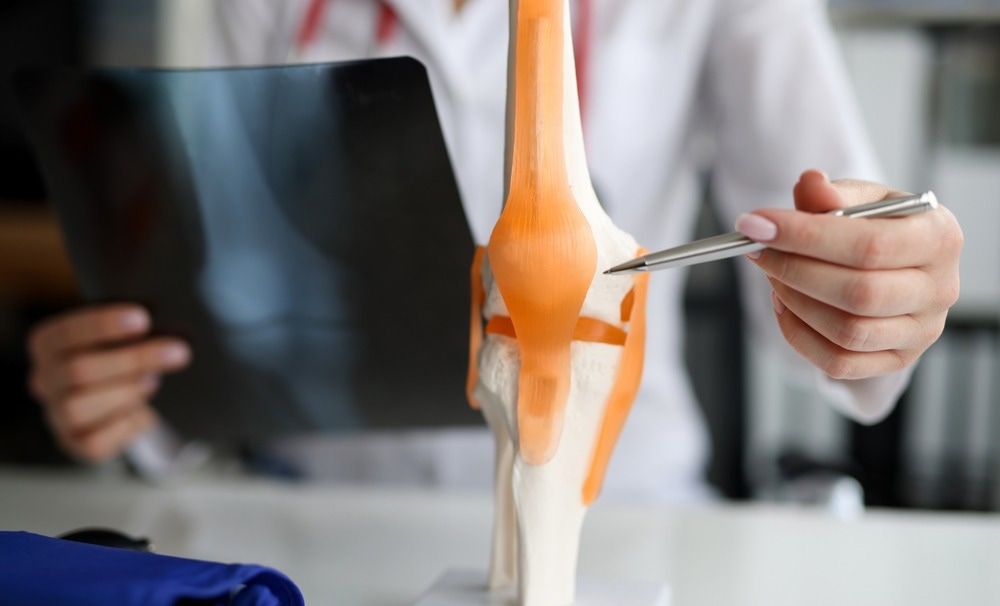In a recent article published in Gels, researchers from China developed multilayer porous plasticized polyvinyl chloride (PVC) gel artificial muscles using carbon nanotube-doped 3D-printed silicone electrodes. Due to their impressive performance characteristics, these artificial muscles show potential applications in human-machine interaction, medical rehabilitation, and flexible electronics.

Image Credit: H_Ko/Shutterstock.com
Background
Artificial muscles are crucial in fields like robotics, flexible electronics, and medical rehabilitation, offering unique capabilities to mimic biological muscle functions. Developing efficient and reliable artificial muscle materials is essential to advancing these applications.
Plasticized polyvinyl chloride (PVC) gel is a promising material for artificial muscles due to its large deformation capabilities, high output stress, thermal stability, and low power consumption. Traditional manufacturing techniques often struggle to achieve the intricate geometries and integrated functionalities needed for optimal artificial muscle performance, creating a need for innovative fabrication approaches to overcome these limitations.
The Current Study
Researchers prepared the composite ink for carbon nanotube-doped silicone electrodes by dispersing multi-walled carbon nanotubes (CNTs) in a polydimethylsiloxane (PDMS) matrix. The CNTs were functionalized to improve their dispersion in the PDMS. The CNT-PDMS composite ink was then formulated by mixing the functionalized CNTs with the PDMS base and curing agent in precise ratios to achieve the desired conductivity and mechanical properties.
The PVC gel ink was prepared by dissolving polyvinyl chloride (PVC) in a mixture of dioctyl adipate (DBA) and tetrahydrofuran (THF). The PVC, DBA, and THF were carefully blended to ensure homogeneity and proper viscosity for the printing process. The ink formulation parameters were optimized to achieve the desired rheological properties for extrusion through the 3D printing nozzles.
CAD software was used to design the planar negative pole, mesh positive pole, and PVC gel core layer structures for the artificial muscles. The printing process involved extruding the CNT-PDMS composite ink for the electrodes and the PVC gel ink for the core layer through a multi-nozzle 3D printing system. For precise structure fabrication, printing parameters such as extrusion pressure and speed were adjusted to control filament diameter and layer thickness.
The printed structures, including the electrodes and core layers, were characterized using scanning electron microscopy (SEM) to analyze the morphology and distribution of CNTs in the silicone matrix. Energy dispersive X-ray spectroscopy (EDS) was employed to determine the elemental composition of the printed composite materials, confirming the presence and dispersion of CNTs in the silicone matrix.
Performance testing of the printed PVC gel actuators was conducted by applying varying voltages and measuring the resulting strain responses. The actuator's deformation under different voltage inputs was recorded, and the strain-voltage relationship was analyzed to evaluate the actuator's performance characteristics. Load testing was also performed to assess the actuator's response to mechanical loads and its potential applications in various fields.
Results and Discussion
SEM analysis revealed well-defined structures of the printed carbon nanotube-doped silicone electrodes and PVC gel core layers. The images showed a uniform CNT distribution within the silicone matrix, indicating the successful incorporation of CNTs in the electrode ink. The porous nature of the PVC gel core layers was evident, showcasing the interconnected network necessary for efficient actuation.
Performance testing of the printed PVC gel actuators demonstrated excellent actuating capabilities under applied voltages. The actuator exhibited a significant strain of 7 % at 800 V, highlighting the artificial muscle's high deformability and responsiveness.
The strain-voltage relationship indicated a linear response, suggesting predictable and controllable actuation behavior. Load testing showed the actuator's ability to withstand mechanical loads, indicating its potential for practical applications.
The conductivity of the carbon nanotube-doped silicone electrodes was crucial for efficient electrical stimulation of the PVC gel artificial muscles. CNTs in the silicone matrix facilitated rapid charge transfer, enhancing actuation performance. The stability of the electrodes in air and under applied voltages was essential for long-term functionality, successfully demonstrated through performance testing.
The integrated printing approach offered significant advantages over traditional manufacturing methods, providing a practical solution to overcome conventional fabrication limitations. Precise control over electrode and core layer structures and enhanced conductivity of CNT-doped electrodes showcased the potential of this approach for the scalable production of advanced artificial muscles.
Conclusion
This study successfully demonstrated the use of CNT-PDMS in manufacturing multilayer artificial muscles via direct writing, highlighting their potential for various applications. The developed PVC gel artificial muscles exhibited excellent performance characteristics, showing promise for future use in human-machine interaction, medical rehabilitation, and flexible electronics. This research provides a practical and straightforward approach to overcoming challenges in artificial muscle fabrication.
Journal Reference
Luo B., et al. (2024). Carbon Nanotube-Doped 3D-Printed Silicone Electrode for Manufacturing Multilayer Porous Plasticized Polyvinyl Chloride Gel Artificial Muscles. Gels. DOI: 10.3390/gels10070416